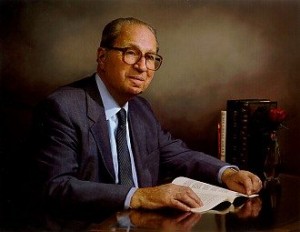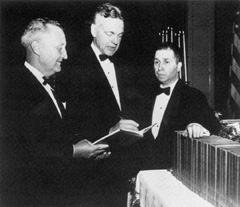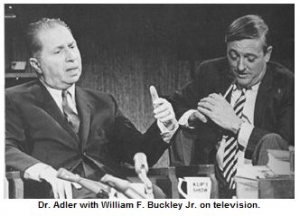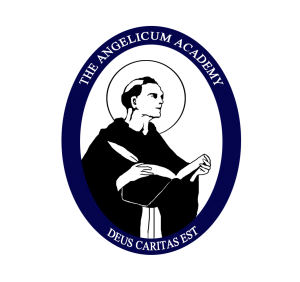
Dr. Mortimer J. Adler
MORTIMER J. ADLER: REFORMING EDUCATION
Dubbed “America’s reigning pedagogue” by William F. Buckley, Jr. on his TV program Firing Line many years ago, Mortimer Jerome Adler is still enthroned and happily reigning. Now 97, Adler has the unique distinction of being the only living person who participated in Socratic discussion groups in 1921 and in 2000 A.D – 79 years later (the latter group this writer attended). In American educational reform annals, the twentieth century may aptly be referred to as Adler’s Era.
Born December 28, 1902 in New York City to immigrants Ignatz and Clarissa (nee Manheim) Adler, a jewelry salesman, and a school teacher, respectively, young Mortimer was a high school drop-out at age 14. He went to work as a copy boy and secretary at the New York Sun newspaper where he hoped to become a journalist. He began taking night classes at Columbia University to learn how to write well.
At Columbia he read the autobiography of the English philosopher John Stuart Mill. Adler was impressed to read that Mill could read Greek at the age of 3 and had read the dialogues of Plato in Greek at the age of 5, yet Adler did not even know who Plato was. So at 15 Adler bought a set of Plato and began a lifelong love of philosophy and the Western intellectual tradition. Adler stayed on at Columbia and received a scholarship. His reputation in the classics – particularly in philosophy – became so great that he was awarded a doctorate in philosophy by Columbia even though he had no bachelor’s degree (Adler found it too much of a nuisance to swim at mid-day for the PE requirement). John Murray Cuddihy wrote in a book review that Adler was “the only Ph.D. in America with no B.A., no M.A., not even a high school diploma.” Columbia later relented and awarded him a bachelor’s degree sixty years later, in 1983, in a graduation ceremony Adler joyfully attended.
 Adler became a teacher of psychology at Columbia, but found his interest was mainly in leading discussions in the great books – the classics. He was a student in the General Honor’s class initiated by Professor John Erskine, an Elizabethan literature teacher and author (Helen of Troy; Galahad). Erskine had his students read one book a week over a two-year period. The books were assembled under the title “Classics of Western Civilization.” A few years later, in describing the course to Robert Hutchins, Adler used the phrase “great books course” to describe both the course and the books. The name stuck, and is commonly used to refer to courses that are devoted exclusively to the study of the great classics of the West, from the classical to the modern. There had been an earlier “great books” course given by Charles M. Gayley in 1901 at Berkeley, but it was Adler (and Hutchins) who popularized the phrase.
Adler became a teacher of psychology at Columbia, but found his interest was mainly in leading discussions in the great books – the classics. He was a student in the General Honor’s class initiated by Professor John Erskine, an Elizabethan literature teacher and author (Helen of Troy; Galahad). Erskine had his students read one book a week over a two-year period. The books were assembled under the title “Classics of Western Civilization.” A few years later, in describing the course to Robert Hutchins, Adler used the phrase “great books course” to describe both the course and the books. The name stuck, and is commonly used to refer to courses that are devoted exclusively to the study of the great classics of the West, from the classical to the modern. There had been an earlier “great books” course given by Charles M. Gayley in 1901 at Berkeley, but it was Adler (and Hutchins) who popularized the phrase.
At Columbia Adler was influenced by Erskine and John Dewey, the pragmatist philosopher who taught there, but most especially by the great books themselves. In short, through his reading, Adler’s teachers became the authors of the classics. Thus influenced more by the thought of Aristotle and Aquinas than by any living teacher, Adler became a believer in absolute and universal truths and values, and so came to fight against Dewey’s view that the scientific method is the preeminent foundation for all thought. Adler wrote that Dewey’s pragmatism results in moral and intellectual chaos, which was spreading into the schools.
His earliest work – Dialectic (1927) – was a summation of the great philosophical and religious ideas of Western civilization. Here he began to apply his formidable analytical skills. The dialogue of the authors of the great books concerning these ideas then helped him integrate his discoveries. Adler later remarked that in this work he confused philosophy with dialectic, so that discussion about philosophical ideas, short of any conclusions, was for him philosophy itself (he made philosophy, he wrote, merely “a consideration of theories in the realm of the possible, rather than an attempt to state truths about the actual world.”), an error he later corrected.
Adler (and later, Scott Buchanan) enlarged Erskine’s basic idea of bringing together various fields for reading, into a broader view including the sciences, literature, religion, history – all fields of knowledge – into one great educational experience. He and others thoughtfully selected the great books in all areas of human knowledge that were already connected into a great dialogue (by means of references, quotations, or refutations among them), yielding a complete reading and discussion curriculum. Thus a generalized course became a generalized curriculum. What had become more and more compartmentalized into distinct and seemingly unrelated fields of specialized knowledge, was integrated into a whole, by one course/curriculum – the great books program. Adler wrote of this, “that one course…was a college in itself – the whole of a liberal education or certainly the core of it. Not just the books we read…but the discussions…highly civil conversations about important themes and in a spirit of inquiry…”
 Adler thus became the great synthesist in education, bringing what had seemed many loose threads of Western genius together into one rope. Yet by withholding his conclusions as to where the rope might lead, or end, he invited students to form their own conclusions, which they could only do by studying and discussing each thread in turn. Thus he preserved the singularity of each thread in his synthesis. Like Socrates, he wanted students to draw out conclusions themselves, in dialectical discussion based on their concurrent readings of selections from the great books. Through the use of the dialectic his goal was for students to understand their own conclusions – not merely to memorize his. Adler wrote that what we memorize we can soon forget, but what we understand we never forget. One corollary is that Adler decried the testing mania of our schools, which measure what students memorize (often in cramming sessions), disgorge onto tests, and then soon forget.
Adler thus became the great synthesist in education, bringing what had seemed many loose threads of Western genius together into one rope. Yet by withholding his conclusions as to where the rope might lead, or end, he invited students to form their own conclusions, which they could only do by studying and discussing each thread in turn. Thus he preserved the singularity of each thread in his synthesis. Like Socrates, he wanted students to draw out conclusions themselves, in dialectical discussion based on their concurrent readings of selections from the great books. Through the use of the dialectic his goal was for students to understand their own conclusions – not merely to memorize his. Adler wrote that what we memorize we can soon forget, but what we understand we never forget. One corollary is that Adler decried the testing mania of our schools, which measure what students memorize (often in cramming sessions), disgorge onto tests, and then soon forget.
Adler’s talent for multi-disciplinary organization and synthesis marked a large part of his subsequent career, and made him the natural choice to be editor of numerous sets of books ranging from Britannica’s Great Books of the Western World (60 vols.), The Great Ideas Program (10 vols.), Gateway to the Great Books (10 vols.), The Annals of America (20 vols.), and Encyclopaedia Britannica (32 vols.) while Chairman of the Board of Editors there, to 50 other books which included much text integrating disparate fields of knowledge (see Adler bibliography above). His Propaedia includes his own unique outline of all human knowledge. The Syntopicon, which he invented, a topical index to the 102 Great Ideas preeminent in the Great Books, pressed his skills. He really bit off more than he could chew in the one year he thought it would take to complete. It finally took a staff of thirty indexers and sixty clerical helpers ten years to complete, at the then-astronomical cost of one million dollars. This, of course, would not have been possible had he not also powerful analytical skills.
 He had many co-workers in his labors, including the poet Mark Van Doren, but the one that stands out the most is Bob Hutchins. Adler convinced Hutchins, who had recently been named president of the University of Chicago, that Hutchins was uneducated. Hutchins was humble enough to accept that judgement and asked Adler to help him, invited him to Chicago, and began the joint study and co-moderating of great books discussion groups there, with Adler. The program met stiff resistance, but Hutchins remained committed to the course (in the “University College”) which gradually made an impact. From both Columbia and Chicago the great books approach to education began to make inroads against the still-dominant “progressive” view of education.
He had many co-workers in his labors, including the poet Mark Van Doren, but the one that stands out the most is Bob Hutchins. Adler convinced Hutchins, who had recently been named president of the University of Chicago, that Hutchins was uneducated. Hutchins was humble enough to accept that judgement and asked Adler to help him, invited him to Chicago, and began the joint study and co-moderating of great books discussion groups there, with Adler. The program met stiff resistance, but Hutchins remained committed to the course (in the “University College”) which gradually made an impact. From both Columbia and Chicago the great books approach to education began to make inroads against the still-dominant “progressive” view of education.
The publication of the huge bestseller How To Read A Book by Adler in 1940 (still in print) made him a household word across the country. The publication of the Britannica Great Books set in 1952, put together by Adler, Hutchins, et al., advanced the classical movement into the homes of average Americans. In the mid-1950s, sales reached nearly 50,000 sets per year and 1 million sets were eventually sold. Thus a course became a curriculum, which became a movement for educational reform: a return to the great works and ideas of Western civilization. Adler became at once America’s reigning pedagogue (he appeared on Firing Line more than any other guest) as well as the object of attack and scorn, particularly by the educational establishment. But at least through the 1950s, Adler was in the ascent as the classics were returning to classrooms and homes across America earning him the titles “supersalesman of philosophy” and “the Charles Atlas of Western Intellection.” After the death of Hutchins in 1977, one name became synonymous with the great books movement: Mortimer J. Adler.
Adler said at the time that “the underestimation of the human intelligence is the worst sin of our time.” He saw his task as the restoration of philosophy “to its proper place in our culture.” Regarding modern philosophy, Adler said (in an interview with Michiko Kakutani of the New York Times) that “the twentieth century, for the most part, is an age in which relativism, skepticism, and subjectivism are rampant, and that’s what I’m mainly fighting against…modern philosophy got off to a bad start when Descartes and Locke committed the ‘besetting sin of modern thought’, they ignored Aristotle.”
After Hutchins left Chicago, two things happened: the faculty at Chicago largely tossed the integrated great books approach overboard; and Hutchins helped Adler raise the funds to initiate the Institute for Philosophical Research. The former event stimulated the reaction of the modern philosophy departments, education departments and entrenched “progressive” teachers’ organizations against the great books classical revival. Ultimately they succeeded in crushing the reform “in the generally iconoclastic and anti-retrospective atmosphere of the middle and late sixties” as Adler wrote. It survives here and there in a few colleges. The other change was that Adler focused more and more on deepening his philosophical inquiries into the realms of the ultimate. Out came books on the great ideas, freedom, justice, love, beauty, happiness, truth, religion, God – which he either wrote or edited for the Institute.
Along with being the father of four sons: Mark, Michael, Douglas and Philip; Adler also helped found the Great Books Foundation, the Aspen Institute, and co-founded the Center for the Study of the Great Ideas (with Max Weismann), in efforts to advance his educational and philosophical ideas. Likewise, in 1982 Adler and a group composed mostly of educators, published The Paideia Proposal: An Educational Manifesto to advance his ideas on reforming education, principally by introducing the Socratic method (“questioning and discussion groups”) into the schools alongside the didactic (“lecturing”) and skills instruction (“coaching”) modes of teaching, with emphasis on the Socratic method increasing with grade levels. Wherever his advice was followed, the fruits were evident in the improved educational environment, academic skills and understanding of the students and teachers involved. Unfortunately, the resistance to reform had long since galvanized in American educational institutions, despite their steadily declining performance (by any measure).
He also promoted the idea that a generalized education, such as the great books and Paideia proposals provide, ought to be pushed back down into the high schools and a Bachelor of Arts degree (B.A.) awarded upon successful completion of that program, at age 16 or so. He maintained that the third level of education – the college or university level – ought to be largely for specialization in one’s chosen area, with some interdisciplinary cross fertilization of ideas in a community of scholars (more of a Hutchins’ focus than Adler’s). Teachers, he believed, should continue a generalized education since they are to be exemplars for their students as professional “learners,” in all areas. He would, therefore, abolish all specialized “teachers’ colleges” and colleges of education.
No longer writing books, Adler told this writer that he was pleased his ideas were now being disseminated into the homeschool movement and that there exists plenty of material in his writings to advance his educational ideas there. Indeed, throughout his long educational career, Dr. Adler focused first on helping educate those outside of the institutional educational environment. This stems partly from the resistance of the “progressive” educational establishment to reform; partly to Adler’s own experience as a self-educated high school drop-out; and partly from his belief and long experience that a complete education could not possibly be obtained in schools – being the work of a lifetime – and that teachers who thought they could produce fully-educated young people did not understand that they too were merely partially-educated learners. He wrote that only by about age 60 had he finally some claim on the possession of wisdom. 37 years later, he claims to be learning still. No one, no matter how old, says Adler, should stop learning. He has taken his own advice. -P.S.J.C
THE ADLER BIBLIOGRAPHY
BOOKS
(1927) Dialetic
(1931) The Nature of Judicial Proof: An Inquiry into the Logical, Legal , and Empirical Aspects of the Law of Evidence (with J. Michael)
(1933) Crime, Law and Social Science (with J. Michael)
(1937) Art and Prudence: A Study of Practical Philosophy
(1937) What Man Has Made of Man: A Study of the Consequences of Platonism and Positivism in Psychology
(1940) The Philosophy and Science of Man: A Collection of Texts as a Foundation for Ethics and Politics
(1940) How toRead a Book: The Art of Getting a Liberal Education
(1941) A Dialectic of Morals: Towards the Foundation of Political Philosophy
(1944) How to Think About War and Peace
(1958) The Revolution in Education (with Milton Mayer)
(1958) The Capitalist Manifesto (with Louis O. Kelso)
(1958) The Idea of Freedom: A Dialectic Examination of the Conceptions of Freedom
(1961) The New Capitalists: A Proposal to Free Economic Growth from the Slavery of Savings (with Louis Kelso)
(1961) The Idea of Freedom: A Dialectic Examination of the Controversies about Freedom
(1961) Great Ideas from the Great Books
(1965) The Conditions of Philosophy: Its Checkered Past, Its Present Disorder, and Its Future Promise
(1966) How to Read a Book: A Guide to Reading the Great Books
(1967) The Difference of Man and the Difference It Makes
(1970) The Time of Our Lives: The Ethics of Common Sense
(1971) The Common Sense of Politics
(1972) How to Read a Book: The Classic Guide to Intelligent Reading (with Charles Van Doren)
(1975) The American Testament (with William Gorman)
(1976) Some Questions About Language: A Theory of Human Discourse and Its Objects
(1977) Philosopher at Large: An Intellectual Autobiography
(1977) Reforming Education: The Schooling of a People and Their Education Beyond Schooling (edited by Geraldine Van Doren)
(1978) Aristotle for Everybody: Difficult Thought Made Easy
(1980) How to Think About God: A Guide for the 20th-Century Pagan
(1981) Six Great Ideas: Truth-Goodness-Beauty-Liberty- Equality-Justice
(1982) The Angels and Us
(1982) The Paideia Proposal: An Educational Manifesto
(1983) How to Speak / How to Listen
(1983) Paideia Problems and Possibilities: A Consideration of Questions Raised by The Paideia Proposal
(1984) A Vision of the Future: Twelve Ideas for a Better Life and a Better Society
(1984) The Paideia Program: An Educational Syllabus (with Members of the Paideia Group)
(1985) Ten Philosophical Mistakes
(1986) A Guidebook to Learning: For a Lifelong Pursuit of Wisdom
(1987) We Hold These Truths: Understanding the Ideas and Ideals of the Constitution
(1988) Reforming Education: The Opening of the American Mind (edited by Geraldine Van Doren)
(1990) Intellect: Mind Over Matter
(1990) Truth in Religion: The Plurality of Religions and the Unity of Truth
(1991) Haves Without Have-Nots: Essays for the 21st Century on Democracy and Socialism
(1991) Desires, Right & Wrong: The Ethics of Enough
(1992) A Second Look in the Rearview Mirror: Further Autobiographical Reflections of a Philosopher at Large
(1992) The Great Ideas: A Lexiocon of Western Thought
(1993) The Four Dimensions of Philosophy: Metaphysical-Moral-Objective- Categorical
(1994) Art, the Arts, and the Great Ideas
(1995) Adler’s Philosophical Dictionary: 125 Key Terms for the Philosopher’s Lexicon
(1996) The New Technology: Servant or Master (with Phillip W. Goetz)
(2000) How to Think About The Great Ideas: From the Great Books of Western Civilization (edited by Max Weismann)
EDITED WORKS
(1940) Scholasticism and Politics
(1952) Great Books of the Western World (52 Vols.)
(1952) A Syntopicon: An Index to the Great Ideas (2 Vols.)
(1961) The Great Ideas Today (1961-77, 17 Vols.) (with Robert Hutchins)
(1963) Gateway to the Great Books (10 Vols.) (with Robert Hutchins)
(1968) The Annals of America (21 Vols.)
(1974) Propaedia: Outline of Knowledge and Guide to The New Encyclopedia Britannica 15th Edition (30 Vols.)
(1977) Great Treasury of Western Thought (with Charles Van Doren)
(1978) The Great Ideas Today (1975-1995 – 18 Vols.)
(1990) Great Books of the Western World 2nd Edition (60 Vols.)
(1990) A Syntopicon: An Index to The Great Ideas 2nd Edition (2 Vols.)

